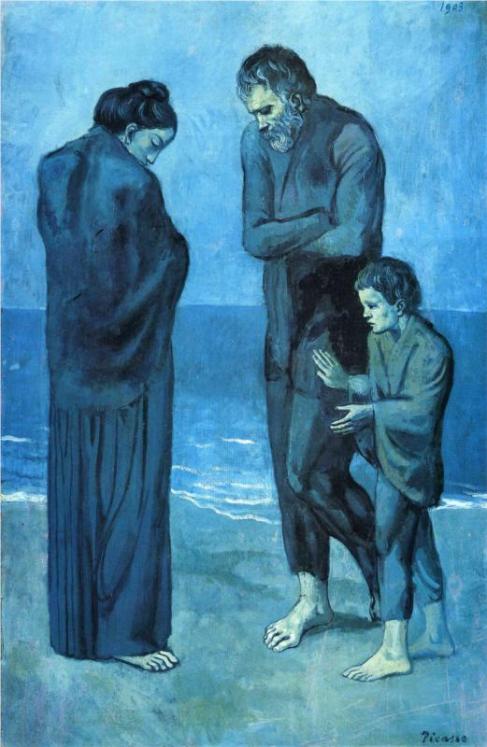Wow, I really have been terrible at this! Time for change!
For my first proper post I would like to just let you all know what I thought of one particular Picasso painting. Picasso’s The Tragedy 1903, currently on display in the National Gallery of Art in Washington, D.C. :
Now, lets put aside for a moment the standard responses to this painting; the family scene, the cast out members of society typical of the Blue period, the analysis of the question ‘why blue?’ etc. I want to talk about one particular aspect that I saw when studying this piece, one that I did not find any research or analysis on. That is not to say that I am the only one who has noticed this, but I could not find published evidence of another person exploring it.
The aspect I am talking (or typing I guess) about is the position of the mother in this painting, both relative to the other figures and relative to the viewer. Firstly, the mother is standing away from her child, very uncharacteristically in terms of the time period and of Picasso’s other works. She should be comforting the child but instead he is forced into some sort of strained interaction with his father. Specifically, we the viewer cannot see the front of the mother, we cannot see her body language, her stance or even really her facial expression. This led me to wonder why. Why are we not shown the front of the woman who is so much the main focus of this painting? Does she not not want us to see her? I came to some sort of realisation that maybe she does not want us to see what is in her arms.
Look at the way in which her right elbow sticks out slightly, as if she is holding something. Or someone. I think that she may be holding another child. Certainly her posture (or as much as we can see from behind) would suggest that she is looking down at something which she is holding in her arms, a young child perhaps, younger than the visible boy. To me, this is as obvious as it is invisible. After finding it I do not know how I could not see it at first viewing, and I feel I must share this realisation. The woman could be holding a child, and alluding to the title; The Tragedy, said child could be passed on. It was indeed common to lose a child in the harsh winters of the time, it would not be surprising if this was in fact discovered to be a family mourning the loss of a baby.
The mother’s facial expression (or what we can see of it) is in stark contrast to the father and the boy, despite them suffering from the same tragedy. They appear to be distraught, the father especially, plagued by the feelings of loss and despair surrounding their situation and looking to the mother for comfort. The mother, however, seems to me to be almost serene, like she is staring down at her baby as a loving mother giving comfort and warmth to a smiling child, not as a mother who has lost her baby. She seems calm, as if she is coming to terms with the loss and beginning to find a way to move forward, maybe finding strength in her child’s face.
Whether this interpretation is accurate or not remains to be seen, I could have gone completely the wrong way but then again, Picasso seems to sometimes hide things from us, sending us on some sort of hunt for the meaning and the reality of the figures depicted. So maybe I am right, maybe this is worth more exploration. What do you think?

So I’m pretty late in posting this, but I just wanted let you know that i just did an analysis of this painting and came to the same conclusion. Even further i believe the son looks like he feels a bit responsible for some reason.